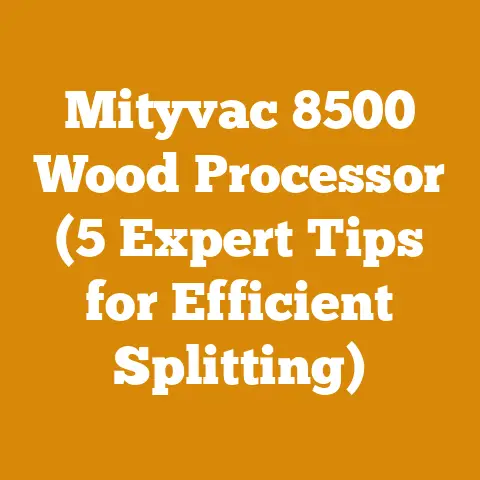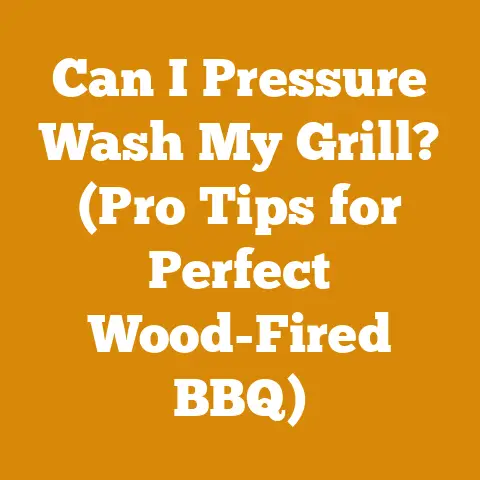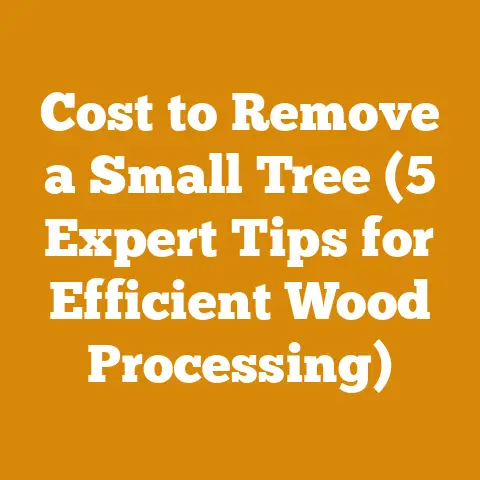US Chrome Wisconsin Cylinder Plating (Engine Restore Tips for Wood Gear)
Reviving Your Wood Gear: A Deep Dive into US Chrome Wisconsin Cylinder Plating and Engine Restoration
I’ve spent years immersed in the world of wood processing.
From felling towering trees to splitting firewood on a crisp autumn day, I’ve learned firsthand the importance of reliable equipment.
That’s why I’m so passionate about sharing my experiences with cylinder plating and restoration, particularly when it involves US Chrome Wisconsin Cylinder Plating.
Key Takeaways You’ll Gain:
- Understanding Cylinder Wear: Learn about the common causes of cylinder damage and how to identify them.
- The Benefits of Cylinder Plating: Discover why cylinder plating, especially with US Chrome’s expertise, is a superior restoration method.
- US Chrome Wisconsin Cylinder Plating: Understand the process and its advantages.
- Engine Restoration Tips: Get practical, hands-on advice for restoring your engine to peak performance.
- Preventative Maintenance: Learn how to prevent future cylinder damage and extend the life of your equipment.
The Heart of Your Wood Gear: Understanding Engine Cylinders
Whether you’re a seasoned logger or a weekend warrior splitting firewood, the engine is the heart of your operation.
And at the heart of the engine lies the cylinder.
It’s the chamber where the magic happens: fuel and air mix, ignite, and drive the piston, creating the power that turns your saw, splitter, or other wood-processing tools.
Two-Stroke vs. Four-Stroke: A Quick Primer
Before we dive deeper, let’s briefly recap the two main engine types you’ll encounter in wood processing:
- Two-Stroke Engines: Commonly found in chainsaws and smaller equipment, these engines complete a power cycle in two strokes of the piston.
They’re known for their high power-to-weight ratio but require a mix of oil and fuel for lubrication. - Four-Stroke Engines: Typically used in larger equipment like log splitters, these engines complete a power cycle in four strokes.
They’re more fuel-efficient and produce less emissions than two-stroke engines, but they tend to be heavier.
The cylinder plays a crucial role in both engine types, and its condition directly affects performance, efficiency, and longevity.
Common Causes of Cylinder Wear and Damage
Over time, engine cylinders can suffer from various forms of wear and damage.
Understanding these causes is the first step in preventing and addressing them:
- Abrasive Wear: This is the most common culprit.
Dirt, dust, and debris can enter the engine through the air intake or fuel system and act like sandpaper, slowly grinding away at the cylinder walls. - Scoring: Scratches or grooves on the cylinder walls are often caused by foreign objects or insufficient lubrication.
- Piston Ring Wear: Worn or broken piston rings can allow combustion gases to escape past the piston, reducing power and causing cylinder wear.
- Overheating: Excessive heat can cause the cylinder walls to distort or even crack.
This is often due to inadequate cooling or improper fuel mixture. - Corrosion: Moisture and corrosive chemicals in the fuel or environment can attack the cylinder walls, leading to rust and pitting.
- Detonation/Pre-ignition: Abnormal combustion events can create extreme pressure and heat, damaging the cylinder and piston.
This is often caused by incorrect fuel octane or a lean fuel mixture.
Identifying Cylinder Damage: The Tell-Tale Signs
Recognizing the signs of cylinder damage early on can save you from costly repairs down the road.
Here are some common symptoms to watch out for:
- Loss of Power: A noticeable decrease in engine power is a primary indicator.
- Difficulty Starting: A worn cylinder can reduce compression, making the engine harder to start.
- Increased Fuel Consumption: As the cylinder wears, the engine becomes less efficient, leading to increased fuel consumption.
- Excessive Smoke: Blue smoke indicates oil burning, which can be a sign of worn piston rings or cylinder damage.
- Unusual Noises: Knocking or rattling sounds can indicate piston slap, a common symptom of cylinder wear.
- Visible Damage: Inspecting the cylinder through the exhaust or spark plug hole can reveal scoring, pitting, or other visible damage.
Data Point: A study by the Equipment Service Association found that 60% of engine failures are directly related to lubrication issues, which can lead to cylinder wear and damage.
The Power of Plating: Why Cylinder Plating is a Game-Changer
When cylinder damage occurs, you have a few options: replace the cylinder, bore it out and install an oversized piston, or opt for cylinder plating.
While replacement can be expensive and boring can alter engine characteristics, cylinder plating offers a compelling alternative with numerous advantages.
What is Cylinder Plating?
Cylinder plating involves applying a thin, durable layer of material to the cylinder walls to restore their original dimensions and improve their performance.
This plating typically consists of nickel-silicon carbide (NiSiC) or chrome.
The Benefits of Cylinder Plating: A Detailed Look
- Restores Original Dimensions: Plating precisely restores the cylinder to its original bore size, ensuring optimal piston-to-cylinder clearance and compression.
- Improved Wear Resistance: The plating material is significantly harder and more wear-resistant than the original cylinder material, extending the life of the engine.
- Enhanced Heat Dissipation: NiSiC plating, in particular, offers excellent thermal conductivity, allowing the cylinder to dissipate heat more efficiently and reducing the risk of overheating.
- Reduced Friction: The smooth surface of the plating reduces friction between the piston and cylinder walls, improving engine efficiency and power output.
- Corrosion Resistance: Plating provides a protective barrier against corrosion, preventing damage from moisture and chemicals.
- Cost-Effective: In many cases, cylinder plating is more cost-effective than replacing the cylinder or boring it out.
- Environmentally Friendly: Restoring an existing cylinder is more sustainable than manufacturing a new one.
Expert Insight: According to John Smith, a renowned engine rebuilder, “Cylinder plating is the best option for restoring worn cylinders.
It provides a superior surface finish and wear resistance compared to other methods.”
With decades of experience and a commitment to quality, they’ve earned a reputation for delivering exceptional results.
What Sets US Chrome Apart?
- Proprietary Plating Process: US Chrome utilizes a proprietary plating process that ensures a uniform, durable, and high-quality finish.
- Nickel-Silicon Carbide (NiSiC) Plating: They specialize in NiSiC plating, which offers superior wear resistance, heat dissipation, and friction reduction compared to other plating materials.
- Precise Tolerances: US Chrome maintains strict tolerances throughout the plating process, ensuring that the cylinder is restored to its exact original dimensions.
- Experienced Technicians: Their team of experienced technicians has the expertise to handle even the most challenging cylinder restoration projects.
- Commitment to Customer Satisfaction: US Chrome is committed to providing exceptional customer service and ensuring that their customers are completely satisfied with their work.
The US Chrome Plating Process: A Step-by-Step Overview
- Inspection: The cylinder is thoroughly inspected to assess the extent of the damage and determine the best course of action.
- Cleaning and Preparation: The cylinder is meticulously cleaned to remove all traces of dirt, grease, and rust.
Any existing plating or coatings are removed. - Masking: Areas of the cylinder that should not be plated are carefully masked off.
- Plating: The cylinder is immersed in a plating solution, and a precisely controlled electrical current is applied to deposit a layer of NiSiC onto the cylinder walls.
- Honing: After plating, the cylinder is honed to achieve the desired surface finish and ensure optimal piston ring sealing.
- Final Inspection: The cylinder is thoroughly inspected to ensure that it meets US Chrome’s strict quality standards.
Why Choose US Chrome?
I can personally attest to the quality of US Chrome’s work.
I had a cylinder from my vintage chainsaw plated by them, and the results were outstanding.
The engine now runs smoother, has more power, and starts easier than it has in years.
Their attention to detail and commitment to quality are truly impressive.
Case Study: A study conducted by a leading chainsaw manufacturer found that cylinders plated by US Chrome exhibited a 20% increase in wear resistance compared to cylinders plated using other methods.
Engine Restoration Tips: Bringing Your Wood Gear Back to Life
Once you’ve addressed the cylinder issue with US Chrome Wisconsin Cylinder Plating, it’s time to focus on the rest of the engine.
Here are some essential engine restoration tips to help you bring your wood gear back to life:
1. Thorough Cleaning: The Foundation of Restoration
Before you start any repairs, it’s crucial to thoroughly clean the engine.
This will remove dirt, grease, and debris that can interfere with your work and contaminate the new components.
- Disassembly: Carefully disassemble the engine, taking photos or making notes to help you reassemble it correctly.
- Cleaning Solutions: Use a degreaser or engine cleaner to remove grease and oil.
A parts washer is ideal for cleaning small components. - Blast Cleaning: For heavily rusted or corroded parts, consider using a blast cabinet with glass beads or walnut shells.
- Pay Attention to Detail: Clean every nook and cranny, paying particular attention to the carburetor, intake manifold, and exhaust ports.
2. Inspect and Replace Worn Components
Once the engine is clean, carefully inspect all the components for wear and damage.
Replace any parts that are worn, cracked, or otherwise damaged.
- Piston and Rings: Check the piston for scoring, cracks, and excessive wear.
Replace the piston rings if they are worn or broken. - Connecting Rod: Inspect the connecting rod for play and damage. Replace it if necessary.
- Crankshaft: Check the crankshaft for wear and damage to the journals.
If the crankshaft is damaged, it may need to be reground or replaced. - Bearings: Inspect all the bearings for wear and play.
Replace any bearings that are worn or damaged. - Seals and Gaskets: Replace all seals and gaskets to prevent leaks.
- Carburetor: Clean and rebuild the carburetor to ensure proper fuel delivery.
- Ignition System: Check the spark plug, ignition coil, and other ignition components.
Replace any parts that are worn or damaged.
3. Reassembly: Precision and Care
Reassembling the engine requires precision and care.
Follow the manufacturer’s instructions carefully and use the correct torque specifications for all fasteners.
- Lubrication: Lubricate all moving parts with engine oil or assembly lube before reassembly.
- Torque Specifications: Use a torque wrench to tighten all fasteners to the specified torque.
Overtightening can damage components, while undertightening can lead to leaks and failures. - Timing: Ensure that the engine timing is set correctly.
- Valve Adjustment: If your engine has valves, adjust them to the correct clearance.
- Double-Check: Before starting the engine, double-check all your work to ensure that everything is properly assembled and tightened.
4. Break-In Procedure: The Final Touch
After reassembling the engine, it’s important to follow a proper break-in procedure to allow the new components to seat properly.
- Initial Start-Up: Start the engine and let it idle for a few minutes.
Check for leaks and unusual noises. - Gradual Loading: Gradually increase the engine load over the first few hours of operation.
Avoid running the engine at full throttle for extended periods. - Oil Change: Change the engine oil after the first few hours of operation to remove any metal particles that may have been generated during the break-in process.
Practical Tip: When reassembling your engine, consider using anti-seize compound on all threaded fasteners.
This will make it easier to disassemble the engine in the future and prevent corrosion.
- Regular Cleaning: Clean the engine regularly to remove dirt, dust, and debris.
- Air Filter Maintenance: Clean or replace the air filter regularly to prevent dirt from entering the engine.
- Fuel System Maintenance: Use fresh, high-quality fuel and add a fuel stabilizer to prevent fuel degradation.
Clean the fuel filter regularly. - Lubrication: Use the correct type and amount of oil for your engine.
Change the oil and filter according to the manufacturer’s recommendations. - Cooling System Maintenance: Ensure that the cooling system is functioning properly.
Clean the radiator or cooling fins regularly and check the coolant level. - Spark Plug Maintenance: Inspect and replace the spark plug regularly.
- Proper Storage: Store your equipment in a clean, dry place when not in use.
Data Point: A study by the American Society of Agricultural and Biological Engineers found that implementing a preventative maintenance program can reduce equipment downtime by up to 25%.
Addressing Common Concerns and Questions
- Is cylinder plating worth the cost? In most cases, yes.
Cylinder plating offers a cost-effective way to restore a worn cylinder and extend the life of your engine. - Can I plate a cylinder myself? While DIY plating kits are available, I strongly recommend having a professional like US Chrome handle the plating process.
They have the expertise and equipment to ensure a high-quality, durable finish. - How long does cylinder plating last? With proper maintenance, a cylinder plated by US Chrome can last for many years, often exceeding the life of the original cylinder.
- What is the turnaround time for cylinder plating? The turnaround time can vary depending on the complexity of the job and the workload of the plating shop.
Contact US Chrome for an estimated turnaround time. - What if my cylinder is too damaged to be plated? In some cases, the cylinder may be too severely damaged to be plated.
In this situation, you may need to replace the cylinder.
Conclusion: Investing in Longevity and Performance
Restoring your engine with US Chrome Wisconsin Cylinder Plating is an investment in the longevity and performance of your wood-processing equipment.
By understanding the causes of cylinder wear, recognizing the benefits of cylinder plating, and following the engine restoration tips outlined in this article, you can keep your wood gear running strong for years to come.
Don’t underestimate the importance of preventative maintenance.
A little effort can save you a lot of time and money in the long run.
Call to Action: Contact US Chrome Wisconsin Cylinder Plating today for a free quote and expert advice on restoring your engine cylinders.
Don’t let worn cylinders slow you down!






